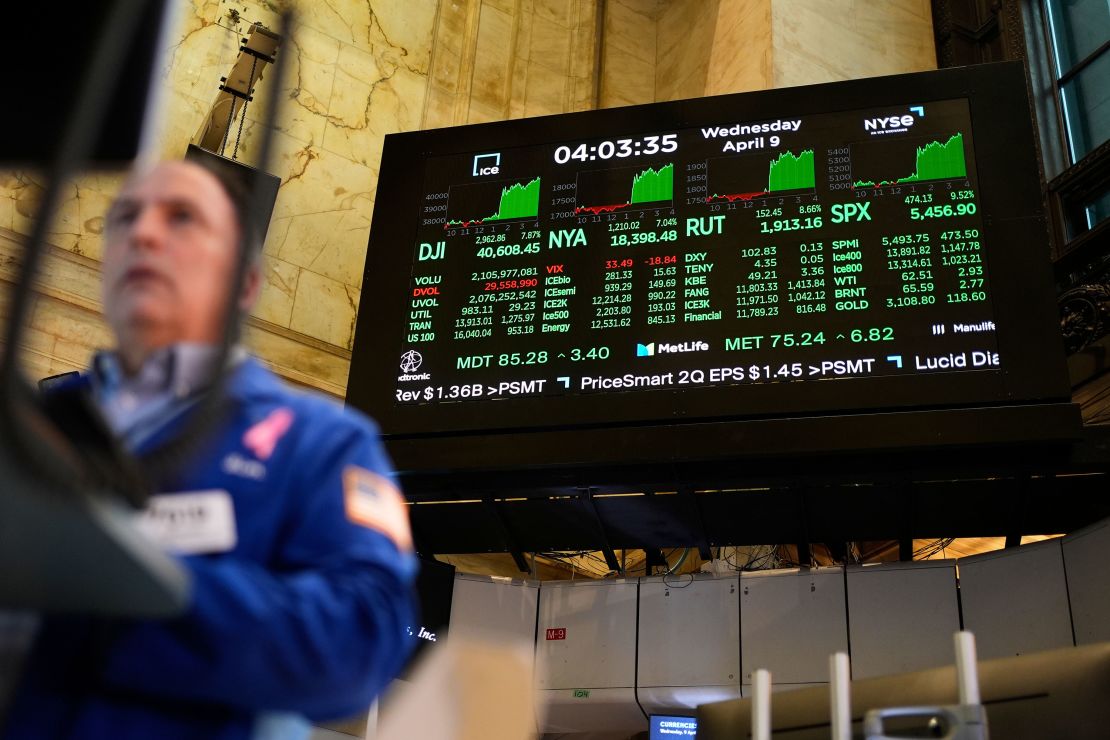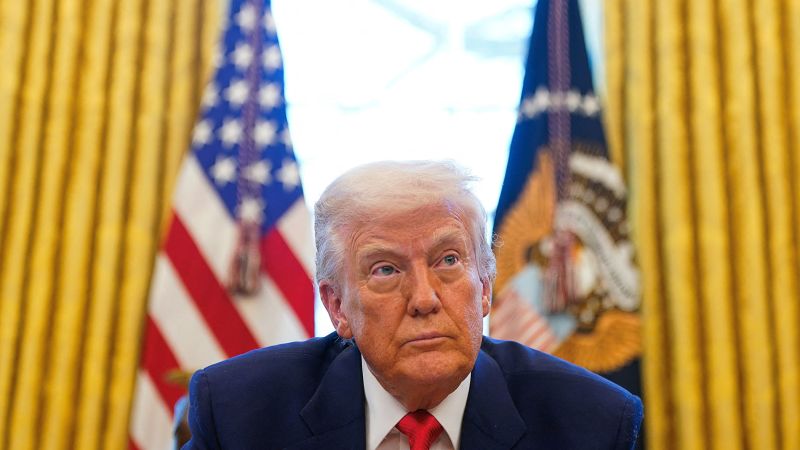A version of this story appeared in CNN Business’ Nightcap newsletter. To get it in your inbox, sign up for free here.
New York
CNN
—
“I guess they say it was the biggest day in financial history,” President Donald Trump told reporters Wednesday afternoon. Later, in an apparent hot-mic moment, he told a fawning senator that the market was up almost seven percentage points. “Nobody’s ever heard of it. It’s gonna be a record.”
It was a historic day, indeed — the third “best” day in the S&P 500’s history. After Trump announced that he was instituting a 90-day pause on most new tariffs (minus China), the Dow added 2,900 points, or nearly 8%. The S&P 500 soared almost 9.5%, its best day since 2008, and the Nasdaq had its second-best day ever, rising more than 12%.
And it was all thanks to Trump — the guy whose extreme agenda (and contradictory messaging around it) became a noose around the neck of global financial markets that were about to enter a doom spiral.
Wall Street’s reaction to his reversal on tariffs is not a victory lap for investors — it’s a gasp for oxygen. Asset prices remain well below where they were a week ago, before Trump announced the tariffs.
The past week cost US stocks $6 trillion in value as market participants prepared for a wildly uncertain future, all while knowing the president is prone to pulling the rug out from under their feet.
Trump is clearly loving the sea of green on the TV stock ticker. But it’s going to take a lot more than one day of stock gains to undo the damage — to the economy and to America’s reputation — that his policies have done.
“My sense here is that the (US) economy is still likely to fall into recession, given the level of simultaneous shocks that it’s absorbed,” Joe Brusuelas, the chief economist of consulting firm RSM, told CNN’s Alicia Wallace. “All this does is postpone temporarily what will likely be a series of punitive import taxes put on US trade allies.”
Trump’s new plan is hardly a full retreat. It leaves in place some of his historic and most aggressive tariffs in place, including 10% tariffs on all virtually all imports coming into the United States and ratchets up tariffs on Chinese imports to 125%. Still in place are 25% tariffs on some goods from Mexico and Canada and 25% tariffs on steel and aluminum imports.
Over the next three months, the White House expects dozens of governments to try to come to the negotiating table to hammer out longer-term deals — a process that would overwhelm even the most disciplined White House, given the complexity that such trade agreements typically require.

Prior to Trump’s tariff pause, RSM raised its recession odds to 55% from 20%. Brusuelas said the recession is likely to occur in next few months.
That’s because businesses have already felt the supply shock and are raising prices in accordance with the White House’s promise.
“Based on anecdotal discussions I’ve had with clients… many of them are going to choose just to leave the products at the docks — they don’t have the cash reserves to pay the tax,” Brusuelas said.
A chorus of economists and analysts were similarly keeping the champagne on ice.
“Even if the administration decides to de-escalate global trade wars and shift their focus to other policy areas, we’re still not out of the woods,” wrote Christian Hoffman, head of fixed income at Thornburg Investment Management, in an email. “Uncertainty remains exceptionally high, and our attention will move away from the president’s tweets and back to economic data to assess the damage that’s been done.”
Tech investor Dan Ives said Trump’s announcement was the news “everyone on the Street was waiting for.” But he called the trade war with China “an epic debacle” that has already done real damage to the economy.
Goldman Sachs economists said the chances of a recession, while slightly lower after Wednesday’s shift, are still elevated, at around 45%. Basically a coin flip.
One of the yarns the White House has been spinning lately is that Trump won’t be moved by the stock market — that the tariff policy was too important to rehabbing America’s economy.
But clearly, Trump’s longtime fixation on the market as a barometer of his presidency hasn’t gone away.
On Monday, as stocks were tumbling, a mysterious, apparently misfired tweet about a 90-day tariff relief plan briefly turned the market around in a wild jolt. The rally only lasted a few minutes, as the White House dismissed the rumor, which ended up on a CNBC chyron, as “fake news.”
But the blip offered a glimpse at what would happen if Trump did decide to put some slack into the noose, giving corporations, government leaders and investors a moment to catch their breath and make a plan.

Sure enough, as the market opened Wednesday morning, Trump posted on Truth Social that “THIS IS A GREAT TIME TO BUY!!!” A few hours later, his tariff plans were on hold and markets immediately turned positive.
The president told CNN’s Jeff Zeleny that he decided to institute the 90-day pause because he thought “people were jumping a little bit out of line — they were getting yippy.”
“I was watching the bond market,” Trump said. “The bond market is very tricky. I was watching it. But if you look at it now, it’s beautiful.”
Of all the financial warning signs plaguing traders over the past week, the bond market’s behavior was by far the scariest.
In normal times, stocks and bonds don’t fall simultaneously. When investors are nervous, they tend to put their money into safe havens like US Treasury bonds, which causes bond prices to go up.
That has not been happening. Instead, investors around the world have been offloading stocks and bonds at the same time, causing stock prices to fall and bond yields (which move inversely to prices) to shoot higher.
That’s a huge red flag, for a variety of reasons. It could mean investors are questioning the US government’s long-term stability. It could also mean investors who lost a ton of money in the market are under pressure to shore up cash to cover their positions. Or it could be a sign that of what Treasury Secretary Scott Bessent, a former hedge funder, called “deleveraging convulsions” — essentially, an unwinding of a popular arbitrage strategy known as a “basis trade” that relies on using loads of borrowed money to buy Treasury bonds.
Whatever the cause, this bond market distress signal has only gone off a handful of times in history — the most recent being 2020 and 2008. (Remember what happened then?)
“The bond market spooked the president,” Ed Yardeni, president of Yardeni Research, told CNN’s Matt Egan. “Bond vigilantes were screaming that they weren’t happy with what was going on and there was a potential for a recession.”

